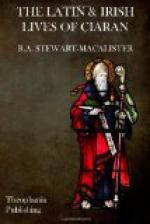In the Lives of Ciaran there are many conventional incidents of this kind, which reappear in the lives of other saints. In the Annotations in the present edition a few such parallels are quoted; though no attempt is made to give an exhaustive list, the compilation of which would occupy more time and space than its scientific value would warrant. But there are certain other incidents of a more individual type, and it is these which make the Lives of Ciaran especially remarkable. They may well be genuine reminiscences of the real life, or at least of the real character of the man himself. Thus, there are a number of coincidences, clearly undesigned (noted below, p. 104) consistently pointing to a pre-Celtic parentage for the saint. Again, the saint’s mother is represented as a strong personality, with a decided strain of “thrawnness” in her composition; while the saint himself is shown to us as distinguished by a beautiful unselfishness. This, it must be confessed, is very far from being a common character of the Irish saints, as they are represented to us by the native hagiologists; and in any case the character-drawing of the average Irish saint’s life is so rudimentary, that when we are thus enabled to detect well-defined traits, we are quite justified in accepting them as based on the tradition of the actual personality of the saint. In other words, so deep was the impression which the man made upon his contemporaries during his short life, that his memorabilia seem to be, on the whole, of a more definitely historic nature than are those of other Irish saints.
There is, however, a disturbing element which must be kept in mind in criticising the Lives of Ciaran. He was the son of a carpenter, and he was said to have died at the age of thirty-three. It is quite clear that these coincidences with the facts of the earthly parentage and death of Christ were observed by the homilists—indeed the author of the Irish Life says as much, at the end of his work. They provoked a natural and perhaps wholly unconscious desire to draw other parallels; and if we may use a convenient German technical term, there is a traceable Tendenz in this direction, as is indicated in the Annotations on later pages. It is not to be supposed that even these apparently imitative incidents are (not to mince matters) mere pious frauds; they may well have come into existence in the folk-consciousness automatically, before they received their present literary form. But such a development could hardly have centred in an unworthy subject; there must have been a well-established tradition of a Christ-likeness of character in the man, for such parallels in detail to have taken shape.[3]




